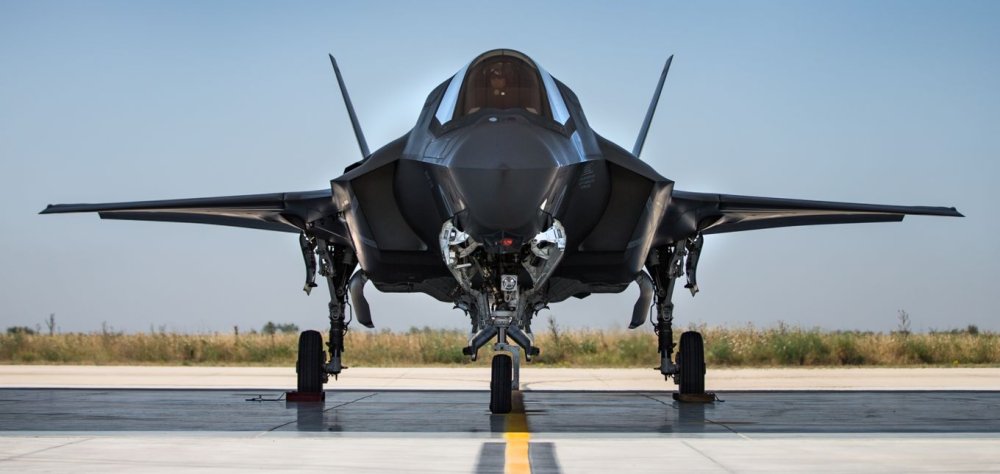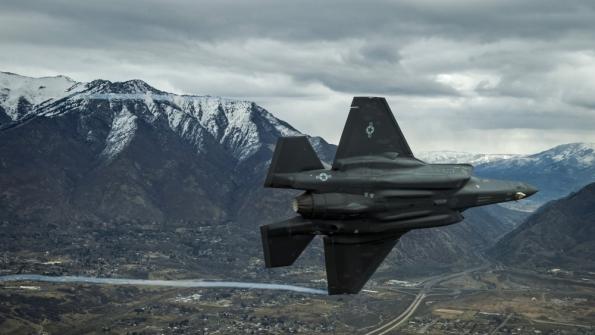The National Interest
Russia is About to Get A Close Look at the F-35 Stealth Fighter

September 26, 2019
Italy has become the first country to deploy F-35 stealth fighters for NATO’s air-policing missions.
Italian F-35As belonging to the Italian air force’s 13° Gruppo, 32° Stormo are on track to take over the air-policing mission in Iceland, David Cenciotti reported at The Aviationist on Sept. 25, 2019.
“The Italian aircraft, that have already deployed to Keflavik International Airport, from their homebase at Amendola air base in southeastern Italy, will start flying familiarisation sorties in the next few days,” Cenciotti wrote. “After achieving the NATO certification they will start quick-reaction alert duties.”
“The F-35s, were accompanied by a KC-767A tanker, a C-130J and a P-72A maritime patrol aircraft,” Cenciotti added, citing data from flight-tracking websites.
F-35s surely will become regular fixtures in NATO deployments. Several NATO countries besides Italy are acquiring F-35s, including the United States, the United Kingdom, The Netherlands, Belgium, Denmark and Norway. Spain has expressed interest in the stealth fighter. Canada seems likely to acquire the type.

Under the air-policing scheme, NATO’s larger members deploy fighters in order to patrol the air space of smaller members that lack their own fighters. The main air-policing destinations are Iceland and the Baltic States. F-15s, F-16s and Typhoons have handled most of the air-policing deployments in the last decade.
The deployments are significant because they put NATO fighters in close contact with Russian warplanes flying along Russia’s western frontier and in North Atlantic air space. It probably won’t be long before NATO F-35s intercept Russian Sukhois.
The F-35 recently has passed several important milestones despite lingering cost, technical and maintenance problems. The Royal Air Force’s F-35Bs flew in combat for the first time on June 16, 2019.
Taking off from the British air base at Akrotiri in Cyprus, a pair of the vertical-landing stealth fighters patrolled over Syria alongside RAF Typhoon fighters, the U.K. Defense Ministry announced.
The F-35s didn’t drop bombs or fire missiles or guns during their combat patrol. Still, the mission made the United Kingdom the third country after Israel and the United States to deploy F-35s in wartime.
The Israeli air force claimed it was the first to fly F-35s in combat. Tel Aviv in May 2018 announced it deployed the radar-evading jet on two fronts. The Israeli government circulated a photo of an Israeli F-35A flying over Beirut in Lebanon during the daytime, strongly implying the fighter struck targets in Lebanon. Israeli warplanes also frequently operate over Syria.
U.S. Marine Corps F-35Bs in September 2018 conducted an air strike in support of what the U.S. Navy described as "ground clearance operations" in Afghanistan. The U.S. Air Force flew its own F-35As in combat for the first time over Iraq in April 2019. The U.S. Navy is still working up its F-35C squadrons for their first front-line cruise aboard an aircraft carrier, currently scheduled for 2021.
The U.S. military plans to begin rotating F-35 stealth fighters into South Korea starting in a few years, a South Korean newspaper reported. The American planes would join a growing fleet of South Korean F-35s.
So far, the U.K. F-35B’s sortie rate in wartime conditions is no better than the sortie rate the remnant fleet of 1980s-vintage Tornadoes achieved in the years preceding their retirement. The eight Royal Air Force Tornadoes at Akrotiri as recently as 2015 managed two, two-ship sorties a day, each lasting six to eight hours, according to Financial Times.
Trade publication Defense News in early June 2019 revealed lingering flaws in the F-35’s design.
At high angles of attack, the F-35B and the carrier-compatible F-35C have a tendency to depart from controlled flight, Defense News reported.
“Specifically, the Marine short-takeoff-and-vertical-landing variant and the Navy’s carrier-launched version become difficult to control when the aircraft is operating above a 20-degree angle of attack, which is the angle created by the oncoming air and the leading edge of the wing,” Defense News explained.
Russia is About to Get A Close Look at the F-35 Stealth Fighter

September 26, 2019
Italy has become the first country to deploy F-35 stealth fighters for NATO’s air-policing missions.
Italian F-35As belonging to the Italian air force’s 13° Gruppo, 32° Stormo are on track to take over the air-policing mission in Iceland, David Cenciotti reported at The Aviationist on Sept. 25, 2019.
“The Italian aircraft, that have already deployed to Keflavik International Airport, from their homebase at Amendola air base in southeastern Italy, will start flying familiarisation sorties in the next few days,” Cenciotti wrote. “After achieving the NATO certification they will start quick-reaction alert duties.”
“The F-35s, were accompanied by a KC-767A tanker, a C-130J and a P-72A maritime patrol aircraft,” Cenciotti added, citing data from flight-tracking websites.
F-35s surely will become regular fixtures in NATO deployments. Several NATO countries besides Italy are acquiring F-35s, including the United States, the United Kingdom, The Netherlands, Belgium, Denmark and Norway. Spain has expressed interest in the stealth fighter. Canada seems likely to acquire the type.
Under the air-policing scheme, NATO’s larger members deploy fighters in order to patrol the air space of smaller members that lack their own fighters. The main air-policing destinations are Iceland and the Baltic States. F-15s, F-16s and Typhoons have handled most of the air-policing deployments in the last decade.
The deployments are significant because they put NATO fighters in close contact with Russian warplanes flying along Russia’s western frontier and in North Atlantic air space. It probably won’t be long before NATO F-35s intercept Russian Sukhois.
The F-35 recently has passed several important milestones despite lingering cost, technical and maintenance problems. The Royal Air Force’s F-35Bs flew in combat for the first time on June 16, 2019.
Taking off from the British air base at Akrotiri in Cyprus, a pair of the vertical-landing stealth fighters patrolled over Syria alongside RAF Typhoon fighters, the U.K. Defense Ministry announced.
The F-35s didn’t drop bombs or fire missiles or guns during their combat patrol. Still, the mission made the United Kingdom the third country after Israel and the United States to deploy F-35s in wartime.
The Israeli air force claimed it was the first to fly F-35s in combat. Tel Aviv in May 2018 announced it deployed the radar-evading jet on two fronts. The Israeli government circulated a photo of an Israeli F-35A flying over Beirut in Lebanon during the daytime, strongly implying the fighter struck targets in Lebanon. Israeli warplanes also frequently operate over Syria.
U.S. Marine Corps F-35Bs in September 2018 conducted an air strike in support of what the U.S. Navy described as "ground clearance operations" in Afghanistan. The U.S. Air Force flew its own F-35As in combat for the first time over Iraq in April 2019. The U.S. Navy is still working up its F-35C squadrons for their first front-line cruise aboard an aircraft carrier, currently scheduled for 2021.
The U.S. military plans to begin rotating F-35 stealth fighters into South Korea starting in a few years, a South Korean newspaper reported. The American planes would join a growing fleet of South Korean F-35s.
So far, the U.K. F-35B’s sortie rate in wartime conditions is no better than the sortie rate the remnant fleet of 1980s-vintage Tornadoes achieved in the years preceding their retirement. The eight Royal Air Force Tornadoes at Akrotiri as recently as 2015 managed two, two-ship sorties a day, each lasting six to eight hours, according to Financial Times.
Trade publication Defense News in early June 2019 revealed lingering flaws in the F-35’s design.
At high angles of attack, the F-35B and the carrier-compatible F-35C have a tendency to depart from controlled flight, Defense News reported.
“Specifically, the Marine short-takeoff-and-vertical-landing variant and the Navy’s carrier-launched version become difficult to control when the aircraft is operating above a 20-degree angle of attack, which is the angle created by the oncoming air and the leading edge of the wing,” Defense News explained.

